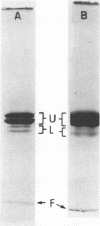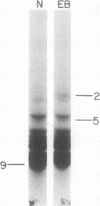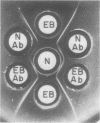Abstract
Recessive dystrophic epidermolysis bullosa, a genodermatosis characterized by dermolytic blister formation in response to minor trauma, is characterized by an incresaed collagenase synthesis by skin fibroblasts in culture. Since preliminary studies of partially purified recessive dystrophic epidermolysis bullosa collagenase suggested that the protein itself was aberrant, efforts were made to purify this enzyme to homogeneity, so that detailed biochemical and immunologic comparisons could be made with normal human skin fibroblast collagenase. Recessive dystrophic epidermolysis bullosa skin fibroblasts obtained from a patient documented to have increased synthesis of the enzyme were grown in large scale tissue culture and both serum-free and serum-containing medium collected as a source of collagenase. The recessive dystrophic epidermolysis bullosa collagenase was purified to electrophoretic homogeneity using a combination of salt precipitation, ion-exchange, and gel-filtration chromatography. In contrast to the normal enzyme, the recessive dystrophic epidermolysis bullosa collagenase bound to carboxymethyl-cellulose at Ca2+ concentrations at least 10 times higher than those used with the normal enzyme. Additionally, this enzyme was significantly more labile to chromatographic manipulations, particularly when serum-free medium was used. However, rapid purification from serum-containing medium yielded a preparation enzymatically equivalent to normal human skin collagenase. Like the normal enzyme, the recessive dystrophic epidermolysis bullosa collagenase was secreted as a set of two closely related zymogens of ∼60,000 and ∼55,000 daltons that could be activated by trypsin to form enzymically active species of ∼50,000 and ∼45,000 daltons, respectively. Amino acid analysis suggested slight variations between the normal and recessive dystrophic epidermolysis bullosa collagenases. Cyanogen bromide digests demonstrated peptides unique to the enzyme from each source. The recessive dystrophic epidermolysis bullosa proenzyme was significantly more thermolabile at 60°C than the normal, a finding that correlated with an approximate fourfold decrease in the affinity of the mutant enzyme for Ca2+, a known activator and stabilizer of human skin collagenase. Aside from the altered affinity for this metal cofactor, kinetic analysis of the structurally altered recessive dystrophic epidermolysis bullosa collagenase revealed that its reaction rates and substrate specificity for human collagen types I-V were identical to those for the normal enzyme. Likewise, enzymes from both sources displayed identical energies of activation and deuterium isotope effects. Antisera were raised to the normal and putatively mutant procollagenases respectively, and, although they displayed a reaction of identity in double diffusion analysis, immunologic differences were present in enzyme inhibition and quantitative precipitation studies. These studies indicate that recessive dystrophic epidermolysis bullosa is characterized by the increased synthesis of an enzymically normal, but structurally aberrant, collagenase.
Full text
PDF










Images in this article
Selected References
These references are in PubMed. This may not be the complete list of references from this article.
- Bauer E. A., Eisen A. Z. Recessive dystrophic epidermolysis bullosa. Evidence for increased collagenase as a genetic characteristic in cell culture. J Exp Med. 1978 Nov 1;148(5):1378–1387. doi: 10.1084/jem.148.5.1378. [DOI] [PMC free article] [PubMed] [Google Scholar]
- Bauer E. A., Gedde-Dahl T., Jr, Eisen A. Z. The role of human skin collagenase in epidermolysis bullosa. J Invest Dermatol. 1977 Mar;68(3):119–124. doi: 10.1111/1523-1747.ep12492226. [DOI] [PubMed] [Google Scholar]
- Bauer E. A. Recessive dystrophic epidermolysis bullosa: evidence for an altered collagenase in fibroblast cultures. Proc Natl Acad Sci U S A. 1977 Oct;74(10):4646–4650. doi: 10.1073/pnas.74.10.4646. [DOI] [PMC free article] [PubMed] [Google Scholar]
- Bauer E. A., Stricklin G. P., Jeffrey J. J., Eisen A. Z. Collagenase production by human skin fibroblasts. Biochem Biophys Res Commun. 1975 May 5;64(1):232–240. doi: 10.1016/0006-291x(75)90243-0. [DOI] [PubMed] [Google Scholar]
- Becker M. A., Kostel P. J., Meyer L. J. Human phosphoribosylpyrophosphate synthetase. Comparison of purified normal and mutant enzymes. J Biol Chem. 1975 Sep 10;250(17):6822–6830. [PubMed] [Google Scholar]
- Becker M. A., Meyer L. J., Seegmiller J. E. Gout with purine overproduction due to increased phosphoribosylpyrophosphate synthetase activity. Am J Med. 1973 Aug;55(2):232–242. doi: 10.1016/0002-9343(73)90174-5. [DOI] [PubMed] [Google Scholar]
- Becker M. A., Meyer L. J., Wood A. W., Seegmiller J. E. Purine overproduction in man associated with increased phosphoribosylpyrophosphate synthetase activity. Science. 1973 Mar 16;179(4078):1123–1126. doi: 10.1126/science.179.4078.1123. [DOI] [PubMed] [Google Scholar]
- Eisen A. Z. Human skin collagenase: relationship to the pathogenesis of epidermolysis bullosa dystrophica. J Invest Dermatol. 1969 May;52(5):449–453. doi: 10.1038/jid.1969.77. [DOI] [PubMed] [Google Scholar]
- Goldberger R. F. Autogenous regulation of gene expression. Science. 1974 Mar 1;183(4127):810–816. doi: 10.1126/science.183.4127.810. [DOI] [PubMed] [Google Scholar]
- Graf L. H., Jr, McRoberts J. A., Harrison T. M., Martin D. W., Jr Increased PRPP synthetase activity in cultured rat hepatoma cells containing mutations in the hypoxanthine-guanine phosphoribosyltransferase gene. J Cell Physiol. 1976 Jul;88(3):331–342. doi: 10.1002/jcp.1040880309. [DOI] [PubMed] [Google Scholar]
- Groves W. E., Davis F. C., Jr, Sells B. H. Spectrophotometric determination of microgram quantities of protein without nucleic acid interference. Anal Biochem. 1968 Feb;22(2):195–210. doi: 10.1016/0003-2697(68)90307-2. [DOI] [PubMed] [Google Scholar]
- Hashimoto I., Schnyder U. W., Anton-Lamprecht I., Gedde-Dahl T., Jr, Ward S. Ultrastructural studies in epidermolysis bullosa hereditaria. III. Recessive dystrophic types with dermolytic blistering (Hallopeau-Siemens types and inverse type). Arch Dermatol Res. 1976 Aug 27;256(2):137–150. doi: 10.1007/BF00567360. [DOI] [PubMed] [Google Scholar]
- King J., Laemmli U. K. Polypeptides of the tail fibres of bacteriophage T4. J Mol Biol. 1971 Dec 28;62(3):465–477. doi: 10.1016/0022-2836(71)90148-3. [DOI] [PubMed] [Google Scholar]
- Laurell A. B., Lindegren J., Malmros I., Mårtensson H. Enzymatic and immunochemical estimation of C'1 esterase inhibitor in sera from patients with hereditary angioneurotic edema. Scand J Clin Lab Invest. 1969 Oct;24(3):221–225. doi: 10.3109/00365516909080156. [DOI] [PubMed] [Google Scholar]
- Lazarus G. S. Collagenase and connective tissue metabolism in epidermolysis bullosa. J Invest Dermatol. 1972 Apr;58(4):242–248. doi: 10.1111/1523-1747.ep12539946. [DOI] [PubMed] [Google Scholar]
- Martin D. W., Jr, Maler B. A. Phosphoribosylpyrophosphate synthetase is elevated in fibroblasts from patients with the Lesch-Nyhan syndrome. Science. 1976 Jul 30;193(4251):408–411. doi: 10.1126/science.180603. [DOI] [PubMed] [Google Scholar]
- Nagai Y., Lapiere C. M., Gross J. Tadpole collagenase. Preparation and purification. Biochemistry. 1966 Oct;5(10):3123–3130. doi: 10.1021/bi00874a007. [DOI] [PubMed] [Google Scholar]
- OUCHTERLONY O. Diffusion-in-gel methods for immunological analysis. Prog Allergy. 1958;5:1–78. [PubMed] [Google Scholar]
- PEARSON R. W. Studies on the pathogenesis of epidermolysis bullosa. J Invest Dermatol. 1962 Dec;39:551–575. doi: 10.1038/jid.1962.156. [DOI] [PubMed] [Google Scholar]
- Paglia L. M., Wiestner M., Duchene M., Ouellette L. A., Hörlein D., Martin G. R., Müller P. K. Effects of procollagen peptides on the translation of type II collagen messenger ribonucleic acid and on collagen biosynthesis in chondrocytes. Biochemistry. 1981 Jun 9;20(12):3523–3527. doi: 10.1021/bi00515a034. [DOI] [PubMed] [Google Scholar]
- Rosen F. S., Alper C. A., Pensky J., Klemperer M. R., Donaldson V. H. Genetically determined heterogeneity of the C1 esterase inhibitor in patients with hereditary angioneurotic edema. J Clin Invest. 1971 Oct;50(10):2143–2149. doi: 10.1172/JCI106708. [DOI] [PMC free article] [PubMed] [Google Scholar]
- Seltzer J. L., Welgus H. G., Jeffrey J. J., Eisen A. Z. The function of Ca+ in the action of mammalian collagenases. Arch Biochem Biophys. 1976 Mar;173(1):355–361. doi: 10.1016/0003-9861(76)90270-8. [DOI] [PubMed] [Google Scholar]
- Shapira E., Ben-Yoseph Y., Eyal F. G., Russell A. Enzymatically inactive red cell carbonic anhydrase B in a family with renal tubular acidosis. J Clin Invest. 1974 Jan;53(1):59–63. doi: 10.1172/JCI107559. [DOI] [PMC free article] [PubMed] [Google Scholar]
- Simpson R. J., Neuberger M. R., Liu T. Y. Complete amino acid analysis of proteins from a single hydrolysate. J Biol Chem. 1976 Apr 10;251(7):1936–1940. [PubMed] [Google Scholar]
- Stricklin G. P., Bauer E. A., Jeffrey J. J., Eisen A. Z. Human skin collagenase: isolation of precursor and active forms from both fibroblast and organ cultures. Biochemistry. 1977 Apr 19;16(8):1607–1615. doi: 10.1021/bi00627a013. [DOI] [PubMed] [Google Scholar]
- Stricklin G. P., Eisen A. Z., Bauer E. A., Jeffrey J. J. Human skin fibroblast collagenase: chemical properties of precursor and active forms. Biochemistry. 1978 Jun 13;17(12):2331–2337. doi: 10.1021/bi00605a012. [DOI] [PubMed] [Google Scholar]
- Sutton H. E., Wagner R. P. Mutation and enzyme function in humans. Annu Rev Genet. 1975;9:187–212. doi: 10.1146/annurev.ge.09.120175.001155. [DOI] [PubMed] [Google Scholar]
- Tschudy D. P., Valsamis M., Magnussen C. R. Acute intermittent porphyria: clinical and selected research aspects. Ann Intern Med. 1975 Dec;83(6):851–864. doi: 10.7326/0003-4819-83-6-851. [DOI] [PubMed] [Google Scholar]
- Valle K. J., Bauer E. A. Biosynthesis of collagenase by human skin fibroblasts in monolayer culture. J Biol Chem. 1979 Oct 25;254(20):10115–10122. [PubMed] [Google Scholar]
- Valle K. J., Bauer E. A. Enhanced biosynthesis of human skin collagenase in fibroblast cultures from recessive dystrophic epidermolysis bullosa. J Clin Invest. 1980 Aug;66(2):176–187. doi: 10.1172/JCI109842. [DOI] [PMC free article] [PubMed] [Google Scholar]
- Welgus H. G., Jeffrey J. J., Eisen A. Z. Human skin fibroblast collagenase. Assessment of activation energy and deuterium isotope effect with collagenous substrates. J Biol Chem. 1981 Sep 25;256(18):9516–9521. [PubMed] [Google Scholar]
- Welgus H. G., Jeffrey J. J., Eisen A. Z. The collagen substrate specificity of human skin fibroblast collagenase. J Biol Chem. 1981 Sep 25;256(18):9511–9515. [PubMed] [Google Scholar]
- Wiestner M., Krieg T., Hörlein D., Glanville R. W., Fietzek P., Müller P. K. Inhibiting effect of procollagen peptides on collagen biosynthesis in fibroblast cultures. J Biol Chem. 1979 Aug 10;254(15):7016–7023. [PubMed] [Google Scholar]
- Wilson J. W. Inherited elevation of alkaline phosphatase activity in the absence of disease. N Engl J Med. 1979 Nov 1;301(18):983–984. doi: 10.1056/NEJM197911013011806. [DOI] [PubMed] [Google Scholar]
- Yoshida A. Amino acid substitution (histidine to tyrosine) in a glucose-6-phosphate dehydrogenase variant (G6PD Hektoen) associated with over-production. J Mol Biol. 1970 Sep 28;52(3):483–490. doi: 10.1016/0022-2836(70)90414-6. [DOI] [PubMed] [Google Scholar]
- Yoshida A., Motulsky A. G. A pseudocholinesterase variant (E Cynthiana) associated with elevated plasma enzyme activity. Am J Hum Genet. 1969 Sep;21(5):486–498. [PMC free article] [PubMed] [Google Scholar]





